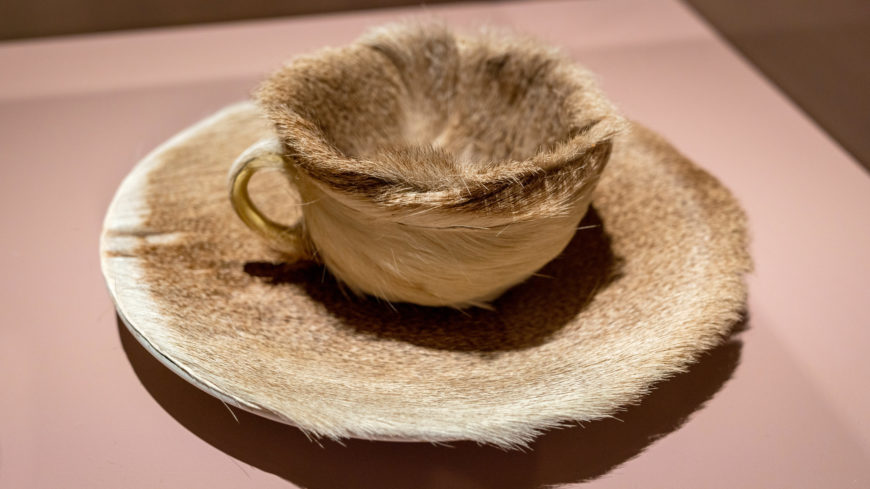Meret Oppenheim, Object (Fur-covered cup, saucer, and spoon)
The story behind the creation of Object, an ordinary cup, spoon, and saucer wrapped evocatively in gazelle fur, has been told so many times its importance in modernist history transcends the fact it might be apocryphal (of dubious authenticity). The twenty-two year old Basel-born artist, Meret Oppenheim, had been in Paris for four years when, one day, she was at a café with Pablo Picasso and Dora Maar. Oppenheim was wearing a brass bracelet covered in fur when Picasso and Maar, who were admiring it, proclaimed, “Almost anything can be covered in fur!” As Oppenheim’s tea grew cold, she jokingly asked the waiter for “more fur.” Inspiration struck—Oppenheim is said to have gone straight from the café to a store where she purchased the cup, saucer, and spoon used in this piece. This amusing story belies the importance of Object and the critical acclaim and public fascination that has elevated it to point where it has become the definitive surrealist object…ultimately to Oppenheim’s dismay.

Visceral Responses
What, then, do we make of this set of be-furred tableware? Interpretations vary wildly. The art historian Whitney Chadwick has described it as linked to the Surrealist’s love of alchemical transformation by turning cool, smooth ceramic and metal into something warm and bristley, while many scholars have noted the fetishistic qualities of the fur-lined set—as the fur imbues these functional, hand-held objects with sexual connotations.
In a 1936 issue of the New Yorker Magazine, it was reported that a woman fainted “right in front of the fur-bearing cup and saucer [while it was on exhibit at MoMA]. “She left no name with the attendants who revived her – only a vague feeling of apprehension.”[1] Such visceral reactions to Oppenheim’s sculpture come closest, perhaps, to what were likely the artist’s aspirations. In an interview later in life, Oppenheim described her creations as “not an illustration of an idea, but the thing itself.”

Unlike Read and Dalí, Oppenheim stresses the physicality of Object, reinforcing the way we can readily imagine the feeling of the fur while drinking from the cup, and using the saucer and spoon. The frisson we experience when china is unexpectedly wrapped in fur is based on our familiarity with both, and the fur requires us to extend our sensory experiences to fully appreciate the work. Object insists we imagine what sipping warm tea from this cup feels like, how the bristles would feel upon our lips. With Oppenheim’s elegant creation, how we understand those visceral memories, how we create metaphors and symbols out of this act of tactile extension, is entirely open to interpretation by each individual, which is, in many ways, the whole point of Surrealism itself.[2]
- Nelson Landsdale and St. Clair McKelway, Talk of the Town, “Critical Note,” The New Yorker, December 26, 1936, p. 7. ↵
- Josh R. Rose, Dr. Steven Zucker and Dr. Beth Harris, "Meret Oppenheim, Object (Fur-covered cup, saucer, and spoon)," in Smarthistory, April 9, 2022, https://smarthistory.org/meret-oppenheim-object-fur-covered-cup-saucer-and-spoon ↵

